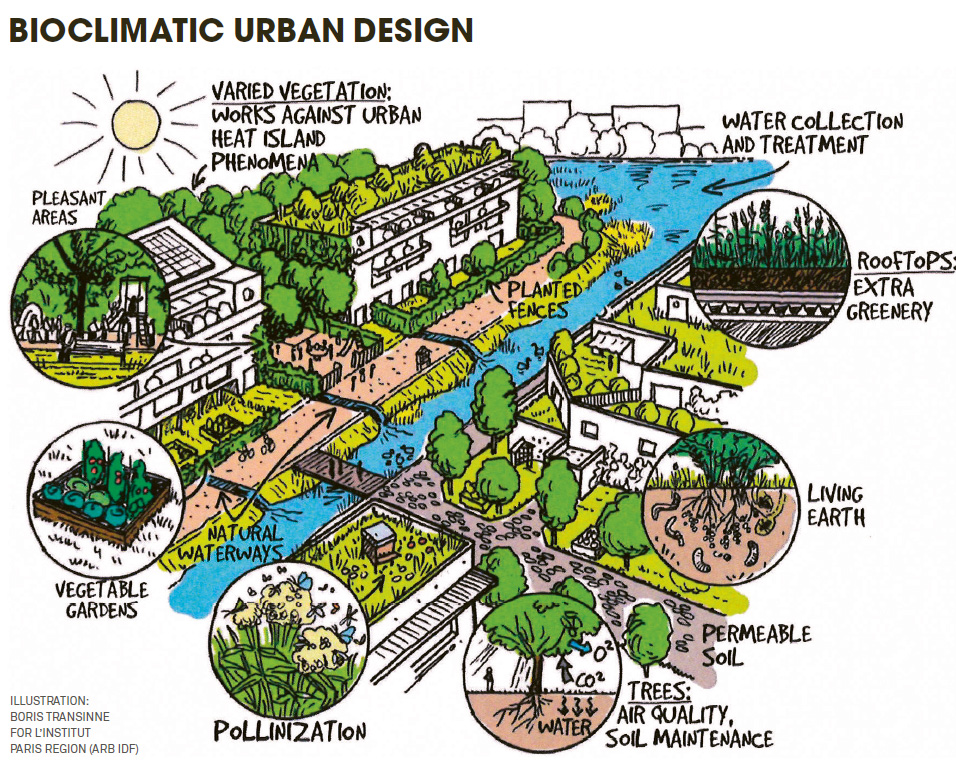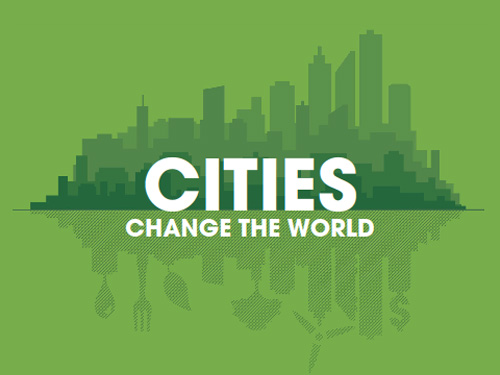Breaking away from a long-standing exclusively technological approach to planning, the Paris Region now teems with initiatives that rely on nature in order to respond to big-city challenges, especially climate change and biodiversity. But the Region still has to coordinate these often very local projects more effectively to make this “Nature City-Region” model more consistent, clear and desirable.
Twenty-five years ago, while the French government was approving a master plan for the Île-de-France region (SDRIF 1994) that was still dominated by issues relating to the planning of “grey infrastructures” to support urban development (power lines, sewage plants and above all roads and railways), the Land of Berlin distinguished itself by backing up its master plan with an ambitious Landschaftsprogramm Artenschutzprogramm, a planning programme focusing on landscape, flora and fauna. This document set out “green infrastructures” that could cheaply fulfil some of the functions that “grey infrastructures” can only perform at considerable cost. For the first time, it identified and protected “priority climate protection zones”, large natural suburban areas extending into, and cooling down, the city via “climate exchange corridors”. Over the next decade, work at the IAU, now L’Institut Paris Region, popularised the Berlin plan in planning circles across the Paris Île-de-France region and awakened curiosity in the “nature-based solutions” being developed in other cities.
Benefits that are now better recognised
Fields and meadows, forests and woodland, ponds and wetlands, parks and gardens… all these spaces are able to bring significant responses to the major challenges faced by large cities, whether it be to curb climate change (by storing carbon in organic form in the ground and in vegetation)or to adapt to its effects (by cooling cities down during heat waves or by capturing storm-water runoff). Some urban strategies proclaim, in the form of slogans, a special preoccupation with one of the effects of climate change, for example runoff and flooding. In 20141 the concept of the “Sponge City” emerged in several localities in China such as the new town of Lingang southeast of Shanghai, where wetlands have been restored, floodable parks created, and thousands of trees planted to store storm-water that can be reused in dry periods. With its “Cool City”2 concept, the city of Stuttgart has sought to improve wind circulation to remove warm air from the city centre during heat waves, using a network of large parks and rows of trees: all building permits are submitted to a meteorologist to ensure that the planned building will not obstruct the air flow. Because they rely in practice on the same three key elements (maintaining the living soil, increasing plant cover, and re-establishing the natural circulation of water), these approaches are convergent: a Sponge City is necessarily cooler thanks to evapotranspiration, and the plant corridors in the Cool City allow it to store water more effectively3. These approaches provide related benefits (water and air purification, biodiversity, and so on), which are all the more significant because the areas are managed ecologically and interconnected by “green-blue grids” on every scale.
A host of initiatives on every scale
On the scale of the metropolitan region, the idea is to make the city more permeable to nature, as in Rome and Stockholm, where natural parks penetrate into the heart of the city. In the Paris Region, the first Regional Ecological Plan drawn up in 2013 sets objectives for the preservation or restoration of “ecological continuities” (reservoirs of biodiversity interconnected by corridors). For the first time it offers, on a fairly detailed scale, an overall image of the regional “green-blue grid”. These objectives are supported by the Regional Master Plan (SDRIF 2013), which introduces more intra-urban connections. The challenge is still to popularise the forms and functions of this metropolitan grid among the general public, using for example an emblematic species (as in Strasbourg, where simulating the movements of red squirrels makes it possible to evaluate local versions of the metropolitan grid), or an off-beat activity (as in Berlin, where the green grid should make it possible to travel from the countryside to the city centre on horseback!) On the scale of the street, projects should encourage the creation of swales (ditches), “rain gardens” and the planting of trees: the city of New York states that it has planted a million trees in the space of ten years!4 Spontaneous planting must also be encouraged by supporting community projects, as in Rennes, Lille and Strasbourg. In the Paris Region, the “planting permit” has been very popular in Paris since 2015, and more recently in Pantin, Saint-Denis and Massy. On the scale of the built or unbuilt plot, maintaining areas of natural soil and increasing plant cover are vital factors. It is also important to promote the use of living roofs on new and old buildings: with almost 30% of its fl at roofs planted, the city of Basel is often called the “greenest city in the world”5. Since 2001, all new “unused” fl at roofs have to be planted, leading to a reduction of night-time temperatures in summer at micro-local level (on roofs) and local level (in the city centre). Other benefits have accrued in terms of sound insulation, air quality, particulate capture, rainwater management, and the longevity of the roofs’ watertight systems. In the Paris Region, the Regional Biodiversity Agency is currently carrying out a new survey on some thirty living roofs in the heart of Paris called “Grooves” (Green ROOfs Verified Ecosystem Services), whose early results show the surprising storage capacity of roofs depending on the texture and depth of the soil, and their ability to spontaneously host a wide range of plants and mosses (at least 268 different species!) The “surface biotope coefficient”, a composite indicator used by the city of Berlin since 1998 in construction projects, sets a planting goal for each plot. It helps to raise awareness of the resources that can be mobilised (soil, planted terraces, roofs, walls and façades, permeable alveolar surfaces, etc.) and of the respective performance of these resources (the most efficient still being natural open ground). On all scales, reclaiming open ground often turns out to be indispensable. The city of Fukuoka offers several examples of unsealing, including converting a former school car park into a water garden designed with the help of pupils and ecologically restoring the banks of a large potable water basin in Onga Fishway Park. As part of the “Strasbourg ça pousse” scheme, the city and metropolitan councils have called on residents’ collectives to unseal and ecologically manage over 5 hectares of public spaces from 2008 onwards (pavements, the areas in front of buildings, and paths in cemeteries). In the Paris Region, the Regional Council has offered funding for unsealing initiatives since 2017 as part of its Plan Vert (Green Plan) call for projects.
Towards a model for the "nature city" in Île-de-France?
All these nature-based solutions remain, however, more difficult to implement in the hearts of large cities, in particular in Paris and its immediate suburbs whose density, which is significantly higher than in other European metropolises, has tended to increase since the 1990s. Even when this increased density does not encroach on areas of open ground, the pressure on these areas is intensified, making them less able to fulfil their functions as natural infrastructures. The total surface area of parks and gardens in the metropolitan core has grown more slowly than the population over recent years, and footfall in the areas that do exist is correspondingly higher. Increased density in Paris and its immediate suburbs must be managed carefully, with an ad hoc approach to the development of urban brownfield sites. It should also go hand in hand with efforts to achieve balance on a broader scale between urban areas and the countryside. The Paris Region has a rich and varied range of contexts that call for a variety of solutions, as shown by the list of towns that have been awarded the title of “French capital of biodiversity” since 2011: towns in the immediate suburbs of Paris (Montreuil, Courbevoie, Rosny-sous- Bois), towns in the outer suburbs (Saint- Prix, Maurecourt), secondary historic towns (Versailles), new towns (Val Maubuée), and rural towns (Bonnelles). The aim is thus not only to support and showcase the many local initiatives that exist at regional level, but also to help produce a model for the “nature city” in the Paris Region: a model that is coherent, clear and desirable, not only in order to bring together regional actors but also, as the researcher Camille Girault6 has shown with regard to Scandinavian cities, to enhance the attractiveness of the Region and the global environmental credentials of France as a whole.
Marc Barra, Ecologist, and Nicolas Laruelle, Urbanist, L’Institut Paris Region
1. “Sponge City” in China – A breakthrough of planning and flood risk management in the urban context. Faith Ka Shun Chan et al., in Land Use Policy, Vol. 76 (2018), p. 772-778.
2. Cool city as a sustainable example of heat island management case study of the coolest city in the world. Reeman Mohammed Rehan, in HBRC Journal, Vol. 12
(2016), p. 191-204.
3. The sponge city concept is not applicable to all types of urban terrain, in particular the limestone, clay and gypsum plateaux characteristic of the Paris Region.
4. www.milliontreesnyc.org
5. Baumann Nathalie and Peiger Philippe,Végétalisation biodiverse et biosolaire des toitures, Eyrolles, 2018.
6. Camille Girault, “L’affirmation de l’exemplarité environnementale comme stratégie de métropolisation des villes nordiques”, EchoGéo, 36, 2016, Online.


